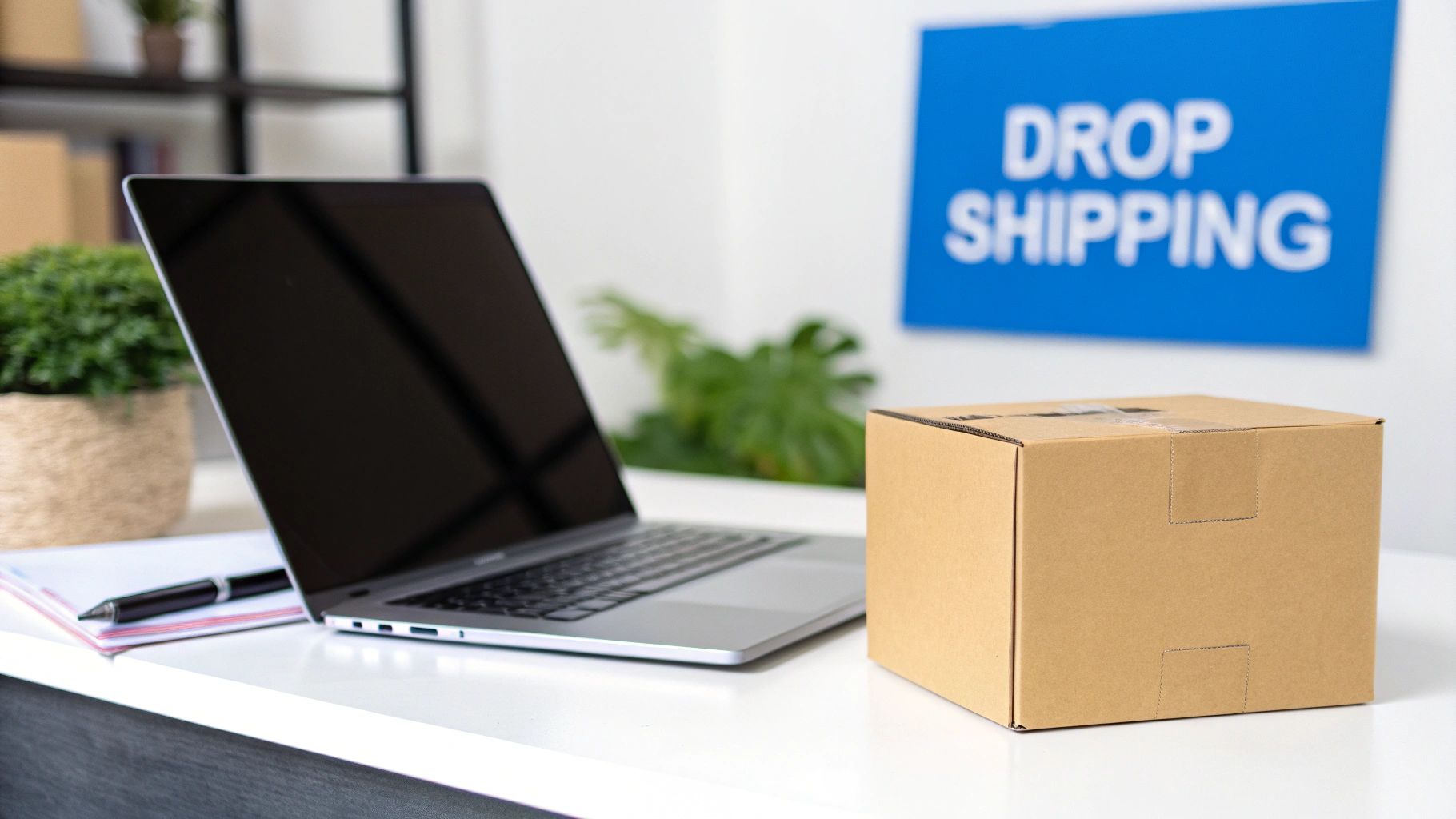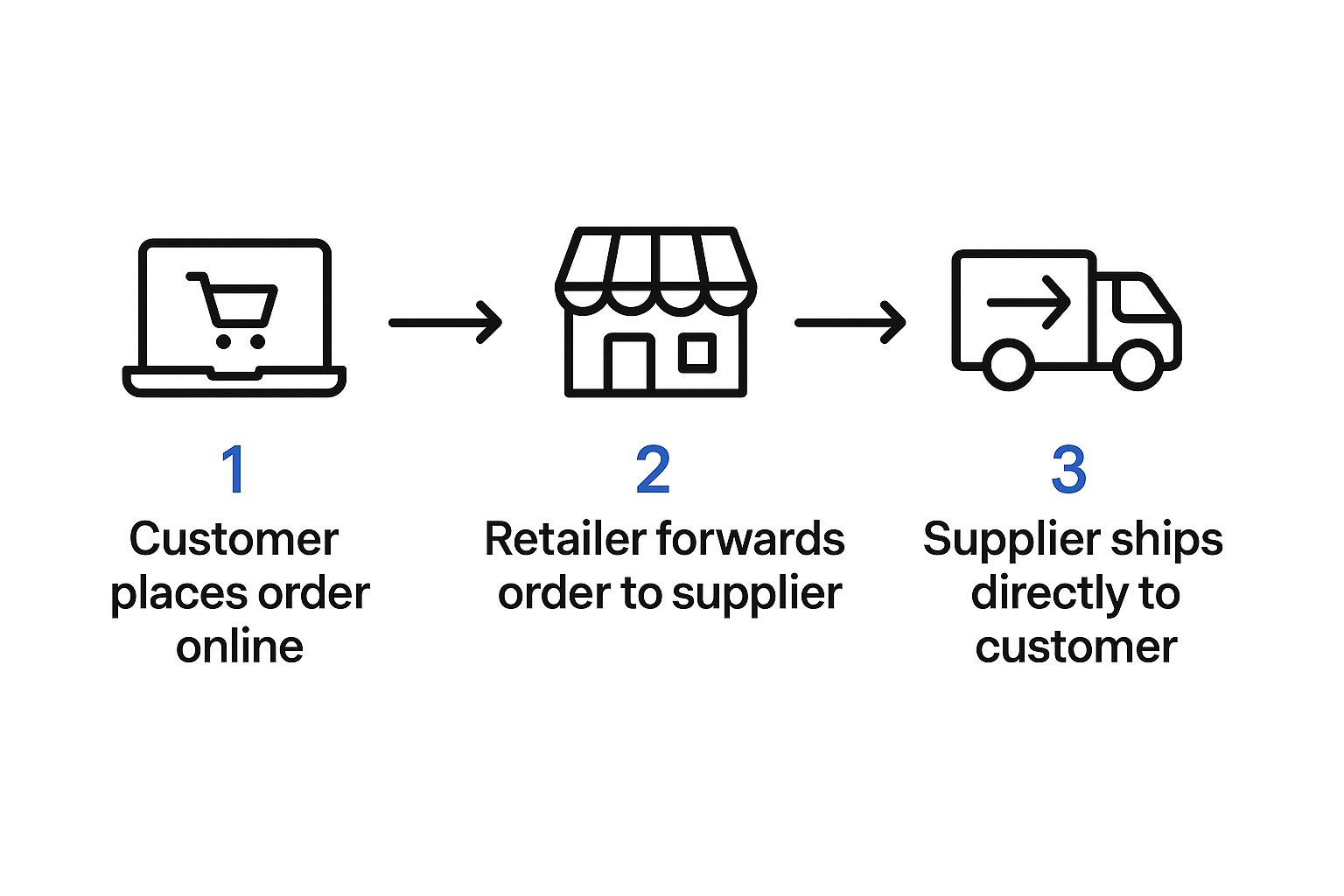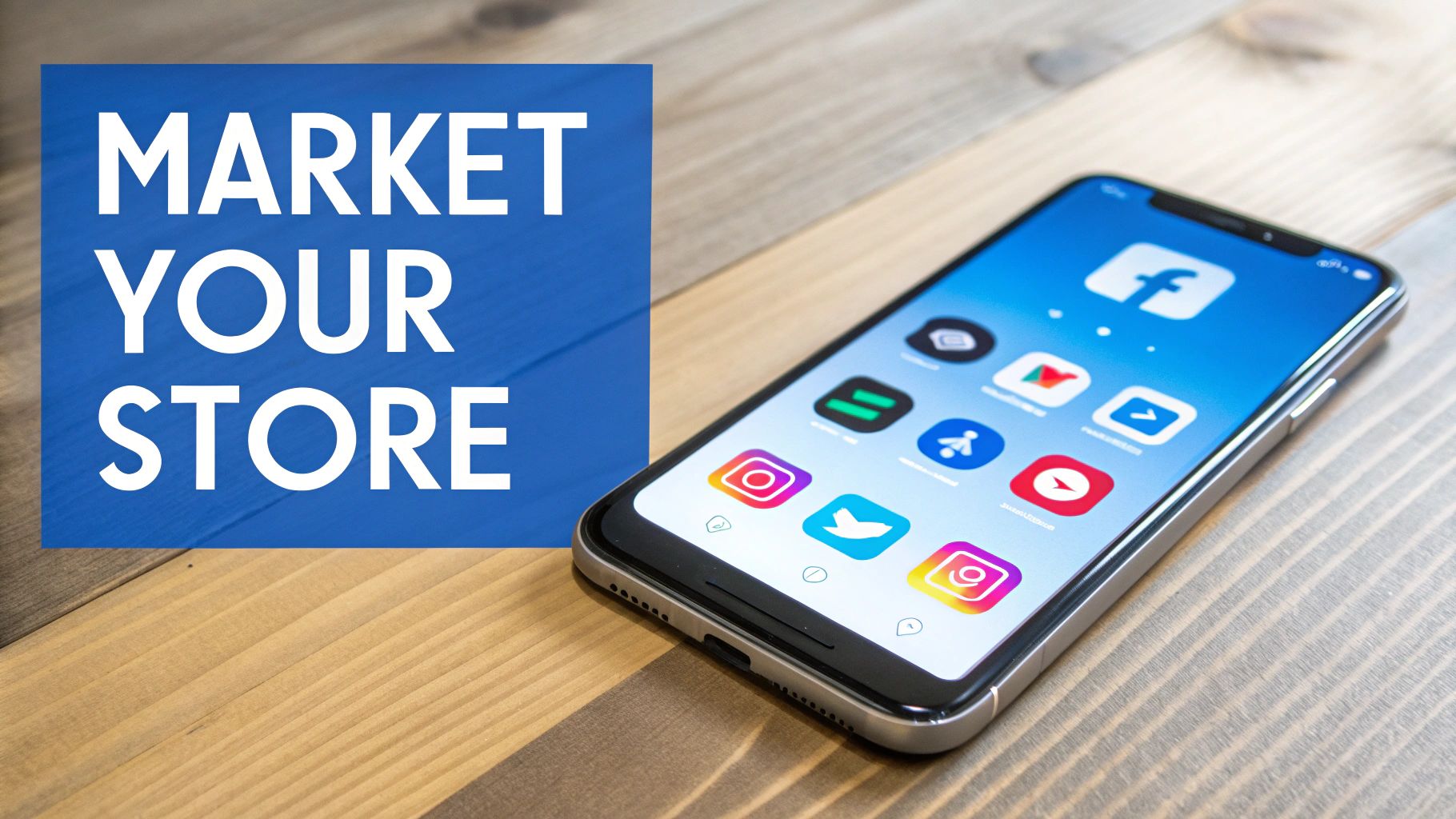Drop shipping is a fascinating model in the world of ecommerce because it flips the traditional retail script on its head. Instead of buying a warehouse full of products and hoping they sell, you sell products without ever holding any inventory yourself.
When a customer places an order on your online store, you then purchase that exact item from a third-party supplier, who ships it directly to your customer. This completely removes the need for managing stock, renting warehouse space, or packing boxes.

Think of yourself less like a traditional store owner and more like a skilled product matchmaker. Your real job is to build a fantastic-looking online storefront, get the word out through great marketing, and provide top-notch customer service. You’re the captain of the digital side of the ship, while someone else handles all the physical logistics—storing, picking, packing, and shipping.
The process is pretty straightforward. An order comes through your website, and you essentially act as the middleman. You collect the payment from your customer, then turn around and place the same order with your supplier, paying them their wholesale price. Your profit is simply the difference between what the customer paid you and what you paid the supplier.
To really get a handle on how drop shipping works, it helps to understand the three core players involved in every single transaction. Each has a specific, vital role to play.
Here's a quick breakdown of who does what:
Each player relies on the others to make the transaction a success. The customer's entire experience is with your brand, even though they receive a package that came directly from a supplier they've never heard of.
The model's popularity is undeniable. About 27% of online retailers use drop shipping as their primary fulfillment method, and it accounts for a staggering 34% of sales on Amazon. These figures show just how deeply this model is woven into the fabric of modern ecommerce.
This hands-off approach to fulfillment is what makes it so appealing. It lets entrepreneurs pour their time and money into what really grows a business: marketing and building a brand. It’s a completely different game from traditional retail, which demands huge upfront investments in inventory.
Of course, it's not the only way to sell online without managing a warehouse. For brands that want more control over their inventory and customer experience, learning what a 3PL is and how it functions can be a game-changing alternative.
To really wrap your head around what drop shipping is, let's walk through a single order. We'll follow it from the moment a customer clicks "buy" on your website to the exciting thud of a package arriving at their front door.
Think of it as a carefully choreographed dance between you, your customer, and your supplier. Your job is to run the digital storefront and keep customers happy, while your supplier takes care of all the physical stuff.
This simple, three-part flow is the heart of the whole model.

As you can see, the process is designed to keep you out of the physical supply chain entirely. This frees you up to focus on what you do best: building your brand and connecting with customers.
It all starts on your turf: your online store. A customer finds a product they love, adds it to their cart, and moves through your checkout. From their point of view, they're buying directly from your brand, and that's exactly how it should feel.
They pop in their payment info and shipping address, and your e-commerce platform—whether it's Shopify, WooCommerce, or another—processes the transaction. The money for the full retail price lands in your account. The order is now officially yours to fulfill.
This is where the drop shipping magic happens. Instead of heading to a stockroom to grab the item and box it up, you simply pass the order details along to your supplier. All they need is the customer's shipping address and the exact product they bought.
In most modern setups, this part is completely automated. An app or integration instantly shoots the order information from your store to your supplier's system the moment it comes in. You then pay your supplier their wholesale price for the product, and the difference is your profit. Simple as that.
Key Takeaway: You are the seller of record. This is a crucial point. Even though the supplier is shipping the product, every piece of communication, every packing slip, and all the branding should come from your store. The customer's relationship is with you, not the invisible supplier in the background.
Once your supplier has the order and your payment, their team takes the baton. They handle all the physical logistics, which means they’re responsible for:
The supplier then gives you a tracking number, which you can immediately share with your customer. This whole flow is fundamental to the model and a key part of how e-commerce fulfillment works in general. Your role wraps up by making sure the customer is thrilled with their purchase and handling any questions they might have.

Just like any business model, drop shipping isn't a silver bullet. It comes with a distinct set of trade-offs. While it offers what seems like an incredibly easy path into ecommerce, it’s certainly not a guaranteed ticket to effortless profits.
Before you jump in, it's crucial to understand both sides of the coin—the powerful upsides and the very real challenges. Getting a clear picture is the only way to know if this model is the right fit for your brand.
Let's start with the most celebrated benefit: the incredibly low barrier to entry. You can get a business off the ground with a surprisingly small amount of cash because you don't have to buy thousands of dollars in inventory upfront.
This single fact dramatically lowers your financial risk. It gives you the freedom to test out new products and ideas without the paralyzing fear of being stuck with a garage full of stuff that won't sell.
This lean-and-mean approach also creates amazing flexibility. You can genuinely run your business from a laptop anywhere with an internet connection. You can also offer a massive catalog of products without ever thinking about warehouse space. If a particular item isn't a hit? You just remove it from your store with a click. No clearance sales, no write-offs.
To break it down, the major draws are:
These perks make it incredibly easy to launch and pivot quickly. But that same accessibility is exactly what creates a crowded, competitive space—which leads us straight into the model's biggest challenges.
While the pros are compelling, the cons are serious enough to sink a business if you're not prepared. The most immediate and painful issue is often the slim profit margins.
With so many stores selling the exact same products from the exact same suppliers, competition gets fierce, and prices get driven down. It’s common for margins to hover between just 10% and 15%. That doesn’t leave a lot of breathing room for marketing, customer support, and all the other costs of running a real business.
The real hidden challenge is the near-total lack of control over the customer experience. You are completely at the mercy of your supplier for product quality, how it's packaged, and how fast it ships. A single unreliable partner can do serious damage to your brand's reputation, even when the problem is completely out of your hands.
This dependency creates another major headache: shipping complexity. Imagine a customer orders three items that come from three different suppliers. You're now on the hook for three separate shipping costs, and your customer is going to get three different packages on three different days. It’s a messy and confusing experience that can feel unprofessional.
Finally, building a unique, memorable brand is incredibly tough when you’re selling the same generic products as dozens of other stores. Without control over custom packaging or the unboxing experience, it becomes much, much harder to stand out from the crowd.
To make the choice clearer, let's put the good and the bad side-by-side. Seeing the direct trade-offs helps you weigh what truly matters for your business goals.
Ultimately, drop shipping is a fantastic tool for testing the market and getting started in ecommerce with minimal risk. But as your brand grows, the lack of control over the customer experience and the slim margins often become major roadblocks.
For businesses looking to build a lasting brand with a loyal following, understanding the differences between drop shipping versus third-party fulfillment is a critical next step. It's the key to figuring out how to scale your operations and take back control of your customer experience.
With the constant buzz around launching online stores, it’s a fair question to ask: can you still make real money with drop shipping?
The short answer is yes. But let's be clear—it's not the hands-off, get-rich-quick scheme some corners of the internet portray it to be. Profitability in today’s market is a game of strategy, not luck.
The market itself is far from shrinking. In fact, its growth is explosive. The global dropshipping market was worth a staggering $286.4 billion in 2023 and is on track to blow past $460 billion by 2025. This massive scale proves demand is stronger than ever, but it also means the competition is fiercer. You can find more details in this in-depth dropshipping market analysis.
Success is no longer about just finding a random trending product on AliExpress. With countless stores often selling the exact same items, you simply can't compete on product alone. Today, profitability hinges on building a legitimate brand, which means you have to excel in the areas where others fall short.
This requires a fundamental shift in your mindset. Instead of thinking like a reseller, you have to operate like a master marketer and a customer service champion. Your ability to create compelling content, run effective ad campaigns, and provide an outstanding support experience is what will set you apart and justify your prices.
The modern drop shipper's success isn't defined by their supplier's catalog but by their own brand's strength. Profitability comes from creating a unique value proposition that goes far beyond just the product itself.
While the low startup cost is a major draw, true profitability is earned through dedicated effort in a few key areas. Think of it less like a passive income stream and more like building a real, sustainable business.
Here’s where successful drop shippers focus their energy:
For many successful eCommerce businesses, drop shipping is the perfect launchpad—but it's rarely the final destination. It’s a brilliant way to test the waters and get a business off the ground with almost zero risk. But once you’ve got traction, the very things that made it so easy to start can become major roadblocks to growth.
This is a natural—and exciting—point in a brand's journey. You've proven your concept and built an audience. Now, the constant headaches of a standard drop shipping model start to feel less like a convenience and more like a constraint. Worrying about your supplier’s stock levels, explaining away inconsistent shipping times, and being unable to create a memorable unboxing experience are frustrating hurdles.
So, how do you take back control without leasing a warehouse and hiring a full-time staff?
The answer lies in a simple but powerful mindset shift: moving from a basic drop ship supplier to a dedicated logistics partner. This is where a Third-Party Logistics (3PL) provider comes into the picture. While both a drop shipper and a 3PL handle fulfillment, the value they bring to a growing brand couldn't be more different.
A standard drop ship supplier relationship is purely transactional. They fulfill one-off orders for products they source and stock. A 3PL, on the other hand, is a strategic partner that manages your own inventory. You buy your products in bulk from a manufacturer—often locking in a much better price—and ship them directly to your 3PL’s fulfillment center. From there, the 3PL stores your inventory and picks, packs, and ships your customer orders for you.
This strategic shift is about graduating from simply reselling products to building a true brand. It’s the move you make when controlling the end-to-end customer experience becomes more important than just avoiding inventory costs.
This hybrid approach directly solves the most common drop shipping pain points, giving ambitious DTC brands a clear roadmap for scaling. As you grow, the quality and nature of your supply chain become critical. For brands focused on higher margins and a premium feel, exploring strategic dropshipping supplier relationships can also be a game-changer for profitability and brand perception.
Understanding the core distinctions makes it crystal clear why partnering with a 3PL is such a critical step for a brand that's ready to scale. At its heart, it’s about trading a little convenience for a lot more control.

The world of drop shipping is blowing up, but it's also growing up. The simple, "set it and forget it" model that once felt like an easy ticket into ecommerce is now running headfirst into a much more demanding market. Winning is no longer just about finding a hot product; it’s about adapting to smarter tech and customers who expect a whole lot more.
On one hand, automation and AI are making it easier than ever to manage orders, answer customer questions, and run marketing campaigns. But on the other, those same customers are now conditioned to expect lightning-fast shipping and a personal touch—something the classic, often slow, drop shipping model wasn't built for.
This push and pull is what’s really shaping the future of the industry. In 2024, the market was already valued at a staggering USD 365.67 billion, and it's on track to blow past USD 464.44 billion by 2025. Some experts even predict it will top USD 1.25 trillion by 2030. You can dig deeper into the numbers by checking out these insights on the dropshipping market.
This kind of explosive growth inevitably means more competition. The brands that will come out on top are the ones who innovate. Today's customers have been trained by giants like Amazon to see two-day shipping and hassle-free returns as the bare minimum. A basic drop shipping setup, with its reliance on overseas suppliers and long wait times, just can't keep up with that new standard.
The future of drop shipping profitability isn't about finding the cheapest supplier. It's about exceeding customer expectations. The businesses that can deliver faster shipping, better quality control, and a brand experience worth remembering are the ones that will win the market.
This new reality is forcing smart entrepreneurs to completely rethink their logistics. They're actively searching for ways to bridge the gap between the low-risk convenience of drop shipping and the premium experience customers now demand.
To stay in the game, many brands are shifting to a hybrid approach. This usually means moving toward a more sophisticated fulfillment strategy that gives them more control and, most importantly, more speed. Instead of relying 100% on a drop shipper, a brand might partner with a 3PL to hold its own inventory for its best-selling products.
This pivot lets them offer the fast, reliable shipping that turns shoppers into loyal customers. At the same time, they can still use the traditional drop shipping model to test out new product ideas without taking on any inventory risk. For any growing brand, getting a handle on what ecommerce fulfillment entails is no longer optional—it's a critical next step. The future belongs to those who adapt.
As you get your head around the drop shipping model, a few practical questions always pop up. It’s one thing to understand the concept, but it's another to know the real-world details that make or break a new store.
Let’s dig into some of the most common questions we hear from entrepreneurs just starting out. Getting clear, straightforward answers is the best way to build the confidence you need to make your move.
One of the biggest draws of drop shipping is how little cash you need upfront, mostly because you're not buying a warehouse full of inventory. Your main costs will be your e-commerce platform subscription (like Shopify, which usually runs $29-$39 per month), a domain name (around $15 per year), and whatever you decide to spend on marketing.
To be realistic, a starting budget between $200 and $500 is a good target. This gives you enough runway to cover the initial setup fees and launch a small, focused ad campaign to start testing products and bringing in your first visitors.
Absolutely, but you have to play by their rules—and they are very strict. For example, Amazon's drop shipping policy demands that you are identified as the seller of record on all paperwork, like invoices and packing slips. You're also on the hook for handling every single customer return.
Crucial Point: Don't even think about cutting corners here. Failing to follow these platform-specific policies is a fast track to disaster. It can quickly lead to a flood of negative reviews, having your selling privileges revoked, or even getting your account permanently suspended. For a new business, that's a death sentence.
It's a classic story: new drop shippers often trip over the same few hurdles. The most common mistakes we see are:
At the end of the day, success comes down to treating your store like a real business from day one. That means putting in the work to do thorough research, building solid relationships with your suppliers, and putting a real marketing plan into action.
Ready to scale past the limits of drop shipping and build a brand with a world-class customer experience? Simpl Fulfillment offers the control and reliability you need. We handle your inventory with precision, offer same-day shipping, and provide custom packaging options that make your brand unforgettable. Stop worrying about logistics and start focusing on growth. See how Simpl Fulfillment can power your brand.